 | –≠–ª–µ–∫—Ç—Ä–æ–Ω–Ω—ã–π –∫–æ–º–ø–æ–Ω–µ–Ω—Ç: X9258US24 | –°–∫–∞—á–∞—Ç—å:  PDF PDF  ZIP ZIP |
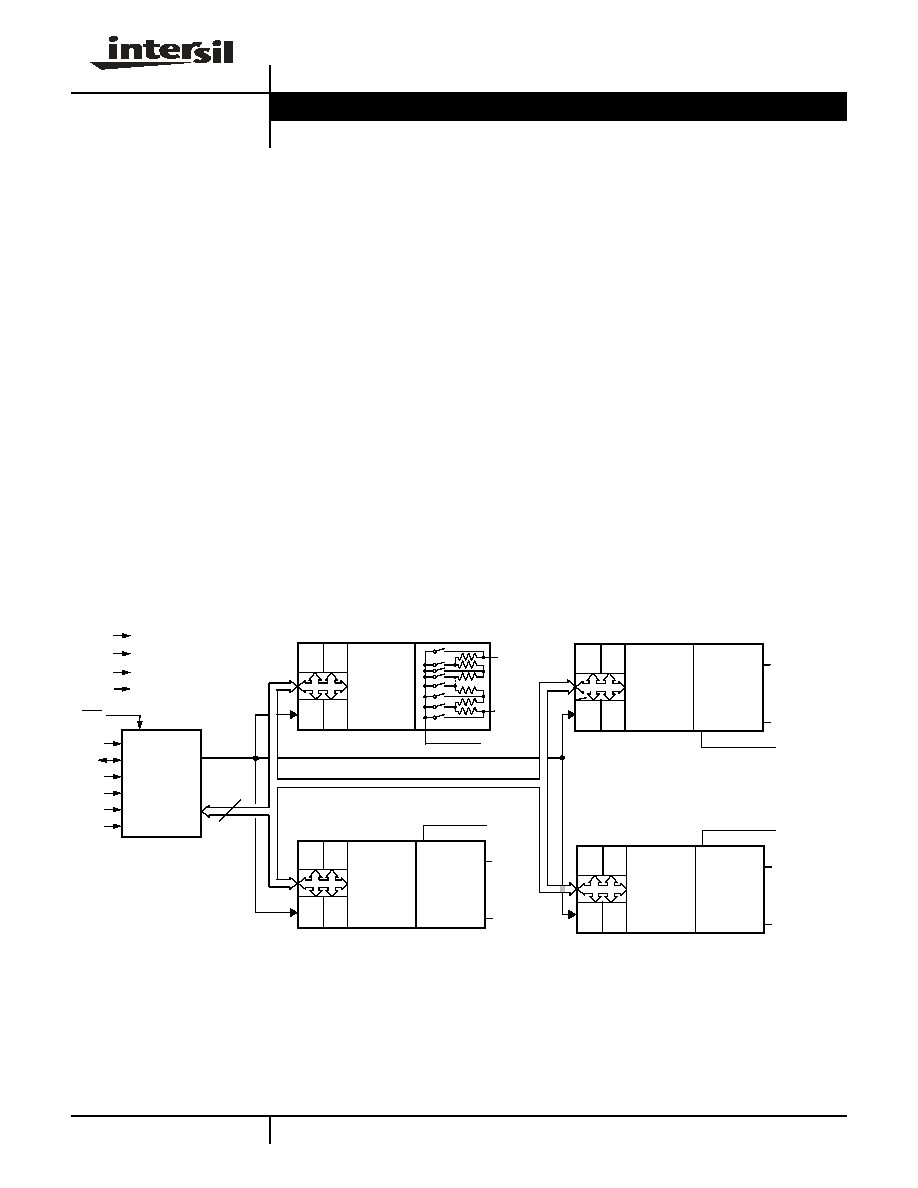
1
Æ
X9258
Low Noise/Low Power/2-Wire Bus/256 Taps
Quad Digital Controlled Potentiometers
(XDCPTM)
FEATURES
∑ Four potentiometers in one package
∑ 256 resistor taps/pot≠0.4% resolution
∑ 2-wire serial interface
∑ Wiper resistance, 40
typical @ V+ = 5V, V- = -5V
∑ Four nonvolatile data registers for each pot
∑ Nonvolatile storage of wiper position
∑ Standby current < 5µA max (total package)
∑ Power supplies
--V
CC
= 2.7V to 5.5V
--V+ = 2.7V to 5.5V
--V- = -2.7V to -5.5V
∑ 100k
, 50k
total pot resistance
∑ High reliability
--Endurance ≠ 100,000 data changes per bit per
register
--Register data retention ≠ 100 years
∑ 24-lead SOIC, 24-lead TSSOP
∑ Dual supply version of X9259
DESCRIPTION
The X9258 integrates 4 digitally controlled
potentiometers (XDCP) on a monolithic CMOS
integrated circuit.
The digitally controlled potentiometer is implemented
using 255 resistive elements in a series array.
Between each element are tap points connected to the
wiper terminal through switches. The position of the
wiper on the array is controlled by the user through the
2-wire bus interface. Each potentiometer has
associated with it a volatile Wiper Counter Register
(WCR) and 4 nonvolatile Data Registers (DR0:DR3)
that can be directly written to and read by the user.
The contents of the WCR controls the position of the
wiper on the resistor array though the switches. Power
up recalls the contents of DR0 to the WCR.
The XDCP can be used as a three-terminal
potentiometer or as a two-terminal variable resistor in
a wide variety of applications including control,
parameter adjustments, and signal processing.
BLOCK DIAGRAM
Interface
and
Control
Circuitry
SCL
SDA
A0
A1
A2
A3
R
0
R
1
R
2
R
3
Wiper
Counter
Register
(WCR)
Resistor
Array
Pot 1
V
H1
/R
H1
V
L1
/R
L1
R
0
R
1
R
2
R
3
Wiper
Counter
Register
(WCR)
V
H0
/R
H0
V
L0
/R
L0
Data
8
V
W0
/R
W0
V
W1
/R
W1
R
0
R
1
R
2
R
3
Resistor
Array
V
H2
/R
H2
V
L2
/R
L2
V
W2
/R
W2
R
0
R
1
R
2
R
3
Resistor
Array
V
H3
/R
H3
V
L3
/R
L3
V
W3
/R
W3
Wiper
Counter
Register
(WCR)
Wiper
Counter
Register
(WCR)
Pot 3
Pot 2
WP
Pot 0
V
CC
V
SS
V+
V-
CAUTION: These devices are sensitive to electrostatic discharge; follow proper IC Handling Procedures.
1-888-INTERSIL or 1-888-352-6832
|
Intersil (and design) is a registered trademark of Intersil Americas Inc.
XDCP is a trademark of Intersil Americas Inc. Copyright Intersil Americas Inc. 2005. All Rights Reserved
All other trademarks mentioned are the property of their respective owners.
Data Sheet
FN8168.1
May 6, 2005

2
FN8168.1
May 6, 2005
PIN DESCRIPTIONS
Host Interface Pins
S
ERIAL
C
LOCK
(SCL)
The SCL input is used to clock data into and out of the
X9258.
S
ERIAL
D
ATA
(SDA)
SDA is a bidirectional pin used to transfer data into
and out of the device. It is an open drain output and
may be wire-ORed with any number of open drain or
open collector outputs. An open drain output requires
the use of a pull-up resistor. For selecting typical
values, refer to the guidelines for calculating typical
values on the bus pull-up resistors graph.
D
EVICE
A
DDRESS
(A
0
- A
3
)
The Address inputs are used to set the least
significant 4 bits of the 8-bit slave address. A match in
the slave address serial data stream must be made
with the address input in order to initiate
communication with the X9258. A maximum of 16
devices may occupy the 2-wire serial bus.
Potentiometer Pins
V
H
/R
H
(V
H0
/R
H0
- V
H3
/R
H3
), V
L
/R
L
(V
L0
/R
L0
-
V
L3
/R
L3
)
The V
H
/R
H
and V
L
/R
L
inputs are equivalent to the
terminal connections on either end of a mechanical
potentiometer.
V
W
/R
W
(V
W0
/R
W0
- V
W3
/R
W3
)
The wiper outputs are equivalent to the wiper output of
a mechanical potentiometer.
Hardware Write Protect Input (WP)
The WP pin when low prevents nonvolatile writes to
the Data Registers.
Analog Supplies V+, V-
The Analog Supplies V+, V- are the supply voltages for
the DCP analog section.
PIN CONFIGURATION
PIN NAMES
PRINCIPLES OF OPERATION
The X9258 is a highly integrated microcircuit
incorporating four resistor arrays and their associated
registers and counters and the serial interface logic
providing direct communication between the host and
the DCP potentiometers.
Serial Interface--2-Wire
The X9258 supports a bidirectional bus oriented
protocol. The protocol defines any device that sends
data onto the bus as a transmitter and the receiving
device as the receiver. The device controlling the
transfer is a master and the device being controlled is
the slave. The master will always initiate data transfers
Symbol
Description
SCL
Serial Clock
SDA
Serial Data
A0-A3
Device Address
V
H0
/R
H0
- V
H3
/R
H3
,
V
L0
/R
L0
- V
L3
/R
L3
Potentiometer Pins
(terminal equivalent)
V
W0
/R
W0
- V
W3
/R
W3
Potentiometers Pins
(wiper equivalent)
WP
Hardware Write Protection
V+,V-
Analog Supplies
V
CC
System Supply Voltage
V
SS
System Ground
NC
No Connection (Allowed)
NC
A0
V
W3
/R
W3
V+
V
CC
V
L0
/R
L0
1
2
3
4
5
6
7
8
9
10
24
23
22
21
20
19
18
17
16
15
A3
SCL
V
L2
/R
L2
V
H2
/R
H2
V
W2
/R
W2
V≠
V
SS
V
W1
/R
W1
V
H1
/R
H1
V
L1
/R
L1
SOIC/TSSOP
X9258
V
H3
/R
H3
14
13
11
12
V
L3
/R
L3
V
H0
/R
H0
V
W0
/R
W0
A2
A1
SDA
WP
X9258

3
FN8168.1
May 6, 2005
and provide the clock for both transmit and receive
operations. Therefore, the X9258 will be considered a
slave device in all applications.
Clock and Data Conventions
Data states on the SDA line can change only during
SCL LOW periods (t
LOW
). SDA state changes during
SCL HIGH are reserved for indicating start and stop
conditions.
Start Condition
All commands to the X9258 are preceded by the start
condition, which is a HIGH to LOW transition of SDA
while SCL is HIGH (t
HIGH
). The X9258 continuously
monitors the SDA and SCL lines for the start condition
and will not respond to any command until this
condition is met.
Stop Condition
All communications must be terminated by a stop
condition, which is a LOW to HIGH transition of SDA
while SCL is HIGH.
Acknowledge
Acknowledge is a software convention used to provide
a positive handshake between the master and slave
devices on the bus to indicate the successful receipt of
data. The transmitting device, either the master or the
slave, will release the SDA bus after transmitting eight
bits. The master generates a ninth clock cycle and
during this period the receiver pulls the SDA line LOW
to acknowledge that it successfully received the eight
bits of data.
The X9258 will respond with an acknowledge after
recognition of a start condition and its slave address
and once again after successful receipt of the
command byte. If the command is followed by a data
byte the X9258 will respond with a final acknowledge.
Array Description
The X9258 is comprised of four resistor arrays. Each
array contains 255 discrete resistive segments that are
connected in series. The physical ends of each array
are equivalent to the fixed terminals of a mechanical
potentiometer (V
H
/R
H
and V
L
/R
L
inputs).
At both ends of each array and between each resistor
segment is a CMOS switch connected to the wiper
(V
W
) output. Within each individual array only one
switch may be turned on at a time. These switches are
controlled by the Wiper Counter Register (WCR). The
8 bits of the WCR are decoded to select, and enable,
one of 256 switches.
The WCR may be written directly, or it can be changed
by transferring the contents of one of four associated
data registers into the WCR. These data registers and
the WCR can be read and written by the host system.
Device Addressing
Following a start condition the master must output the
address of the slave it is accessing. The most
significant four bits of the slave address are the device
type identifier (refer to Figure 1 below). For the X9258
this is fixed as 0101[B].
Figure 1. Slave Address
The next four bits of the slave address are the device
address. The physical device address is defined by the
state of the A0 - A3 inputs. The X9258 compares the
serial data stream with the address input state; a
successful compare of all four address bits is required
for the X9258 to respond with an acknowledge. The A
0
- A
3
inputs can be actively driven by CMOS input
signals or tied to V
CC
or V
SS
.
Acknowledge Polling
The disabling of the inputs, during the internal
nonvolatile write operation, can be used to take
advantage of the typical 5ms nonvolatile write cycle
time. Once the stop condition is issued to indicate the
end of the nonvolatile write command the X9258
initiates the internal write cycle. ACK polling can be
initiated immediately. This involves issuing the start
condition followed by the device slave address. If the
X9258 is still busy with the write operation no ACK will
be returned. If the X9258 has completed the write
operation an ACK will be returned and the master can
then proceed with the next operation.
1
0
0
A3
A2
A1
A0
Device Type
Identifier
Device Address
1
X9258
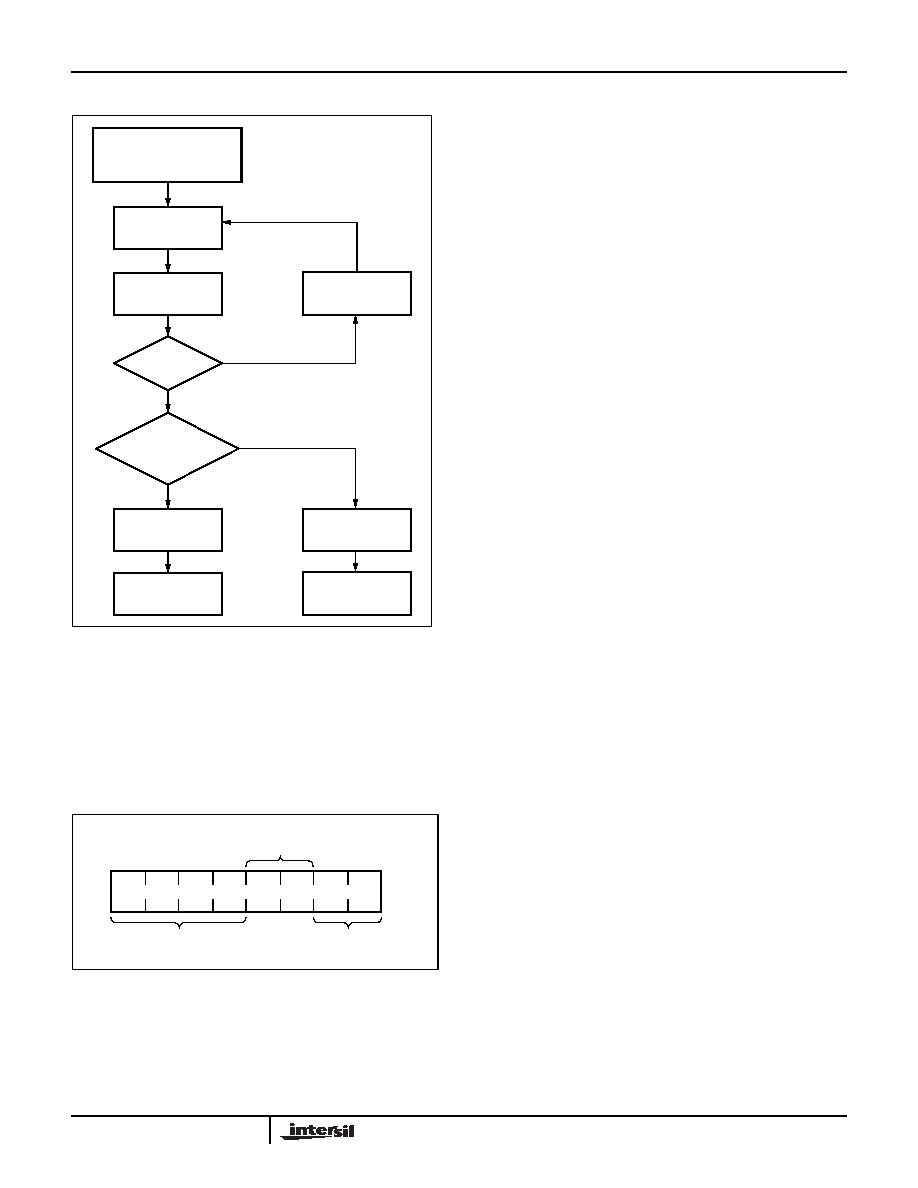
4
FN8168.1
May 6, 2005
ACK Polling Sequence
Instruction Structure
The next byte sent to the X9258 contains the
instruction and register pointer information. The four
most significant bits are the instruction. The next four
bits point to one of the two pots and when applicable
they point to one of four associated registers. The
format is shown below in Figure 2.
Figure 2. Instruction Byte Format
The four high order bits define the instruction. The next
two bits (R1 and R0) select one of the four registers
that is to be acted upon when a register oriented
instruction is issued. The last bits (P1, P0) select
which one of the four potentiometers is to be affected
by the instruction.
Four of the nine instructions end with the transmission
of the instruction byte. The basic sequence is
illustrated in Figure 3. These two-byte instructions
exchange data between the Wiper Counter Register
and one of the data registers. A transfer from a Data
Register to a Wiper Counter Register is essentially a
write to a static RAM. The response of the wiper to this
action will be delayed t
WRL
. A transfer from the Wiper
Counter Register (current wiper position), to a data
register is a write to nonvolatile memory and takes a
minimum of t
WR
to complete. The transfer can occur
between one of the four potentiometers and one of its
associated registers; or it may occur globally, wherein
the transfer occurs between all of the potentiometers
and one of their associated registers.
Four instructions require a three-byte sequence to
complete. These instructions transfer data between
the host and the X9258; either between the host and
one of the data registers or directly between the host
and the Wiper Counter Register. These instructions
are: Read Wiper Counter Register (read the current
wiper position of the selected pot), Write Wiper
Counter Register (change current wiper position of the
selected pot), Read Data Register (read the contents
of the selected nonvolatile register) and Write Data
Register (write a new value to the selected data
register). The sequence of operations is shown in
Figure 4.
Nonvolatile Write
Command Completed
EnterACK Polling
Issue
START
Issue Slave
Address
ACK
Returned?
Further
Operation?
Issue
Instruction
Issue STOP
No
Yes
Yes
Proceed
Issue STOP
No
Proceed
I1
I2
I3
I0
R1
R0
P1
P0
Wiper Counter
Register
Select
Instructions
Register Select
X9258

5
FN8168.1
May 6, 2005
Figure 3. Two-Byte Instruction Sequence
The Increment/Decrement command is different from
the other commands. Once the command is issued
and the X9258 has responded with an acknowledge,
the master can clock the selected wiper up and/or
down in one segment steps; thereby, providing a fine
tuning capability to the host. For each SCL clock pulse
(t
HIGH
) while SDA is HIGH, the selected wiper will
move one resistor segment towards the V
H
terminal.
Similarly, for each SCL clock pulse while SDA is LOW,
the selected wiper will move one resistor segment
towards the V
L
/R
L
terminal. A detailed illustration of
the sequence and timing for this operation are shown
in Figures 5 and 6 respectively.
Table 1. Instruction Set
Note:
(1) 1/0 = data is one or zero
S
T
A
R
T
0
1
0
1
A3
A2
A1
A0
A
C
K
I3
I2
I1
I0
R1
R0
P1 P0
A
C
K
SCL
SDA
S
T
O
P
Instruction
Instruction Set
Operation
I
3
I
2
I
1
I
0
R
1
R
0
P
1
P
0
Read Wiper Counter
Register
1
0
0
1
0
0
1/0
1/0
Read the contents of the Wiper Counter Register
pointed to by P
1
- P
0
Write Wiper Counter
Register
1
0
1
0
0
0
1/0
1/0
Write new value to the Wiper Counter Register
pointed to by P
1
- P
0
Read Data Register
1
0
1
1
1/0
1/0
1/0
1/0
Read the contents of the Data Register pointed
to by P
1
- P
0
and R
1
- R
0
Write Data Register
1
1
0
0
1/0
1/0
1/0
1/0
Write new value to the Data Register pointed to
by P
1
- P
0
and R
1
- R
0
XFR Data Register to
Wiper Counter Register
1
1
0
1
1/0
1/0
1/0
1/0
Transfer the contents of the Data Register pointed
to by P
1
- P
0
and R
1
- R
0
to its associated Wiper
Counter Register
XFR Wiper Counter
Register to Data
Register
1
1
1
0
1/0
1/0
1/0
1/0
Transfer the contents of the Wiper Counter Reg-
ister pointed to by P
1
- P
0
to the Data Register
pointed to by R
1
- R
0
Global XFR Data
Registers to Wiper
Counter Registers
0
0
0
1
1/0
1/0
0
0
Transfer the contents of the Data Registers
pointed to by R
1
- R
0
of all four pots to their re-
spective Wiper Counter Registers
Global XFR Wiper
Counter Registers
to Data Register
1
0
0
0
1/0
1/0
0
0
Transfer the contents of both Wiper Counter
Registers to their respective data Registers
pointed to by R
1
- R
0
of all four pots
Increment/Decrement
Wiper Counter Register
0
0
1
0
0
0
1/0
1/0
Enable Increment/decrement of the Control Latch
pointed to by P
1
- P
0
X9258

6
FN8168.1
May 6, 2005
Figure 4. Three-Byte Instruction Sequence
Figure 5. Increment/Decrement Instruction Sequence
F
Figure 6. Increment/Decrement Timing Limits
S
T
A
R
T
0
1
0
1
A3 A2 A1 A0 A
C
K
I3
I2
I1
I0
R1 R0 P1 P0 A
C
K
SCL
SDA
S
T
O
P
A
C
K
D7
D6 D5 D4 D3 D2
D1 D0
S
T
A
R
T
0
1
0
1
A3 A2 A1 A0
A
C
K
I3
I2
I1
I0
R0 P1 P0
A
C
K
SCL
SDA
S
T
O
P
I
N
C
1
I
N
C
2
I
N
C
n
D
E
C
1
D
E
C
n
R1
SCL
SDA
V
W
/R
W
INC/DEC
CMD
Issued
Voltage Out
t
WRID
X9258
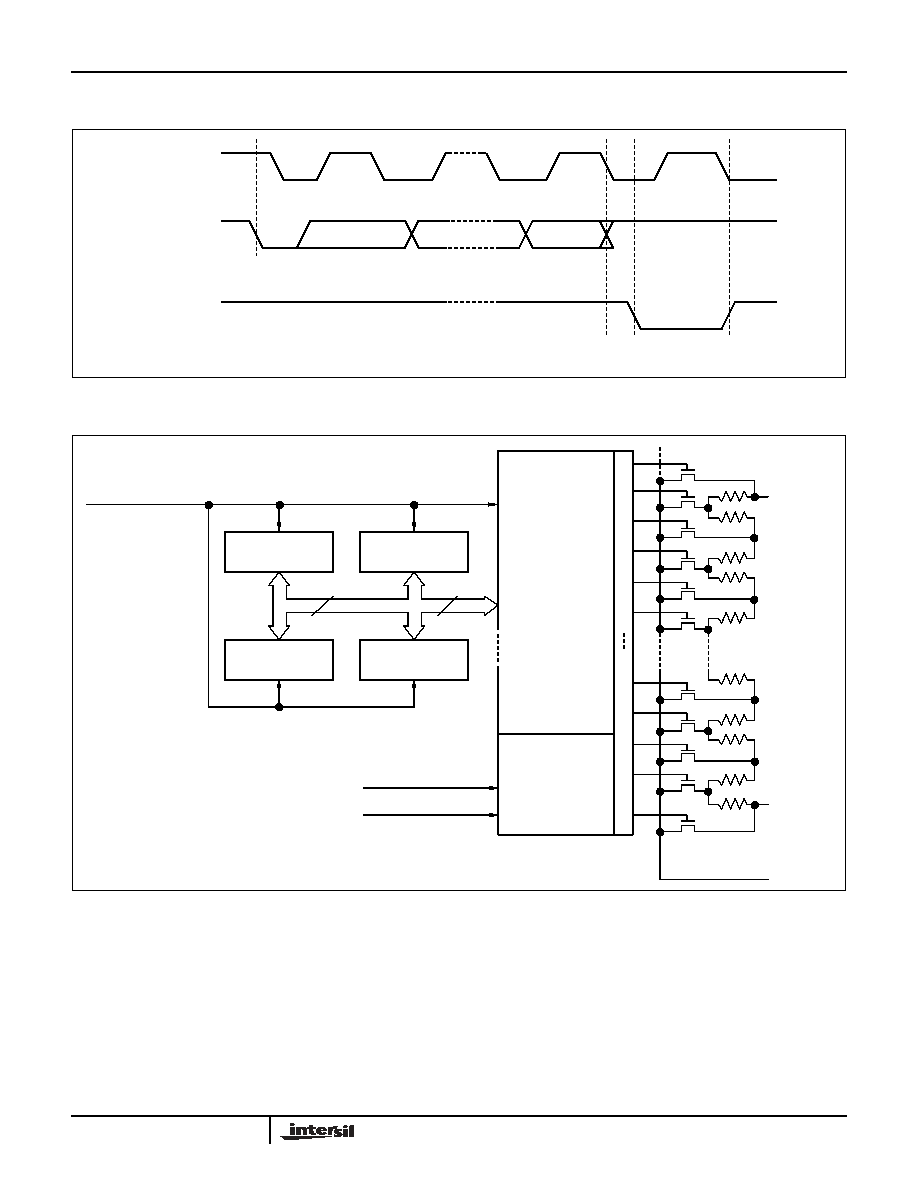
7
FN8168.1
May 6, 2005
Figure 7. Acknowledge Response from Receiver
Figure 8. Detailed Potentiometer Block Diagram Detailed Operation
All DCP potentiometers share the serial interface and
share a common architecture. Each potentiometer has
a Wiper Counter Register and four Data Registers. A
detailed discussion of the register organization and
array operation follows.
Wiper Counter Register
The X9258 contains four Wiper Counter Registers,
one for each DCP potentiometer. The Wiper Counter
Register can be envisioned as a 8-bit parallel and
serial load counter with its outputs decoded to select
one of 256 switches along its resistor array. The
contents of the WCR can be altered in four ways: it
may be written directly by the host via the Write Wiper
Counter Register instruction (serial load); it may be
written indirectly by transferring the contents of one of
four associated Data Registers via the XFR Data
Register instruction (parallel load); it can be modified
one step at a time by the Increment/Decrement
instruction. Finally, it is loaded with the contents of its
data register zero (R0) upon power-up.
SCL from
Data Output
1
8
9
START
Acknowledge
Master
from Transmitter
Data Output
from Receiver
Serial Data Path
From Interface
Circuitry
Register 0
Register 1
Register 2
Register 3
Serial
BUS
Input
Parallel
BUS
Input
Wiper
Counter
Register
INC/DEC
Logic
UP/DN
CLK
Modified SCL
UP/DN
V
H
/R
H
V
L
/R
L
V
W
/R
W
If WCR = 00[H] then V
W
/R
W
= V
L
/R
L
If WCR = FF[H] then V
W
/R
W
= V
H
/R
H
8
8
C
o
u
n
t
e
r
D
e
c
o
d
e
(WCR)
X9258

8
FN8168.1
May 6, 2005
The WCR is a volatile register; that is, its contents are
lost when the X9258 is powered-down. Although the
register is automatically loaded with the value in R0
upon power-up, it should be noted this may be
different from the value present at power-down.
Data Registers
Each potentiometer has four nonvolatile Data
Registers. These can be read or written directly by the
host and data can be transferred between any of the
four Data Registers and the WCR. It should be noted
all operations changing data in one of these registers
is a nonvolatile operation and will take a maximum of
10ms.
If the application does not require storage of multiple
settings for the potentiometer, these registers can be
used as regular memory locations that could possibly
store system parameters or user preference data.
REGISTER DESCRIPTIONS
Data Registers, (8-Bit), Nonvolatile
Four 8-bit Data Registers for each DCP. (sixteen 8-bit
registers in total).
≠ {D7~D0}: These bits are for general purpose not
volatile data storage or for storage of up to four
different wiper values. The contents of Data Register
0 are automatically moved to the wiper counter
register on power-up.
Wiper Counter Register, (8-Bit), Volatile
Instruction Format
Notes: (1) "MACK"/"SACK": stands for the acknowledge sent by the master/slave.
(2) "A3 ~ A0": stands for the device addresses sent by the master.
(3) "X": indicates that it is a "0" for testing purpose but physically it is a "don't care" condition.
(4) "I": stands for the increment operation, SDA held high during active SCL phase (high).
(5) "D": stands for the decrement operation, SDA held low during active SCL phase (high).
Read Wiper Counter Register (WCR)
Write Wiper Counter Register (WCR)
Read Data Register (DR)
WP7
WP6
WP5
WP4
WP3
WP2
WP1
WP0
NV
NV
NV
NV
NV
NV
NV
NV
(MSB)
(LSB)
WP7
WP6
WP5
WP4
WP3
WP2
WP1
WP0
S
T
A
R
T
device type
identifier
device
addresses
S
A
C
K
instruction
opcode
WCR
addresses
S
A
C
K
wiper position
(sent by slave on SDA)
M
A
C
K
S
T
O
P
0
1
0
1
A
3
A
2
A
1
A
0
1
0
0
1
0
0
P
1
P
0
W
P
7
W
P
6
W
P
5
W
P
4
W
P
3
W
P
2
W
P
1
W
P
0
S
T
A
R
T
device type
identifier
device
addresses
S
A
C
K
instruction
opcode
WCR
addresses
S
A
C
K
Data Byte
(sent by master on SDA)
S
A
C
K
S
T
O
P
0
1
0
1
A
3
A
2
A
1
A
0
1
0
1
0
0
0
P
1
P
0
W
P
7
W
P
6
W
P
5
W
P
4
W
P
3
W
P
2
W
P
1
W
P
0
S
T
A
R
T
device type
identifier
device
addresses
S
A
C
K
instruction
opcode
DR and WCR
addresses
S
A
C
K
Data Byte
(sent by slave on SDA)
M
A
C
K
S
T
O
P
0
1
0
1
A
3
A
2
A
1
A
0
1
0
1
1
R
1
R
0
P
1
P
0
W
P
7
W
P
6
W
P
5
W
P
4
W
P
3
W
P
2
W
P
1
W
P
0
X9258

9
FN8168.1
May 6, 2005
Write Data Register (WR)
XFR Data Register (DR) to Wiper Counter Register (WCR)
XFR Wiper Counter Register (WCR) to Data Register (DR)
Increment/Decrement Wiper Counter Register (WCR)
Global XFR Data Register (DR) to Wiper Counter Register (WCR)
Global XFR Wiper Counter Register (WCR) to Data Register (DR)
S
T
A
R
T
device type
identifier
device
addresses
S
A
C
K
instruction
opcode
DR and WCR
addresses
S
A
C
K
Data Byte
(sent by master on SDA)
S
A
C
K
S
T
O
P
HIGH-VOLTAGE
WRITE CYCLE
0 1 0 1
A
3
A
2
A
1
A
0
1 1 0 0
R
1
R
0
P
1
P
0
W
P
7
W
P
6
W
P
5
W
P
4
W
P
3
W
P
2
W
P
1
W
P
0
S
T
A
R
T
device type
identifier
device
addresses
S
A
C
K
instruction
opcode
DR and WCR
addresses
S
A
C
K
S
T
O
P
0 1 0 1
A
3
A
2
A
1
A
0
1 1 0 1
R
1
R
0
P
1
P
0
S
T
A
R
T
device type
identifier
device
addresses
S
A
C
K
instruction
opcode
DR and WCR
addresses
S
A
C
K
S
T
O
P
HIGH-VOLTAGE
WRITE CYCLE
0 1 0
1
A
3
A
2
A
1
A
0
1 1
1
0
R
1
R
0
P
1
P
0
S
T
A
R
T
device type
identifier
device
addresses
S
A
C
K
instruction
opcode
WCR
addresses
S
A
C
K
increment/decrement
(sent by master on SDA)
S
T
O
P
0
1
0
1
A
3
A
2
A
1
A
0
0
0
1
0
0
0
P
1
P
0
I/
D
I/
D
.
.
.
.
I/
D
I/
D
S
T
A
R
T
device type
identifier
device
addresses
S
A
C
K
instruction
opcode
DR
addresses
S
A
C
K
S
T
O
P
0
1
0
1
A
3
A
2
A
1
A
0
0
0
0
1
R
1
R
0
0
0
S
T
A
R
T
device type
identifier
device
addresses
S
A
C
K
instruction
opcode
DR
addresses
S
A
C
K
S
T
O
P
HIGH-VOLTAGE
WRITE CYCLE
0 1 0 1
A
3
A
2
A
1
A
0
1 0 0 0
R
1
R
0
0 0
X9258

10
FN8168.1
May 6, 2005
SYMBOL TABLE
Guidelines for Calculating Typical Values of Bus
Pull-Up Resistors
WAVEFORM
INPUTS
OUTPUTS
Must be
steady
Will be
steady
May change
from Low to
High
Will change
from Low to
High
May change
from High to
Low
Will change
from High to
Low
Don't Care:
Changes
Allowed
Changing:
State Not
Known
N/A
Center Line
is High
Impedance
120
100
80
40
60
20
20
40
60
80 100 120
0
0
Resi
stan
ce (K)
Bus Capacitance (pF)
Min.
Resistance
Max.
Resistance
R
MAX
=
C
BUS
t
R
R
MIN
=
IOL MIN
V
CC MAX
=1.8k
X9258

11
FN8168.1
May 6, 2005
ABSOLUTE MAXIMUM RATINGS
Temperature under bias..................... -65
∞
C to +135
∞
C
Storage temperature ......................... -65
∞
C to +150
∞
C
Voltage on SDA, SCL or any address input
with respect to V
SS
................................. -1V to +7V
Voltage on V+ (referenced to V
SS
) ........................ 10V
Voltage on V- (referenced to V
SS
) ........................-10V
(V+) - (V-)............................................................... 12V
Any V
H
/R
H
...............................................................V+
Any V
L
/R
L
................................................................. V-
Lead temperature (soldering, 10 seconds) ........ 300
∞
C
I
W
(10 seconds)................................................±15mA
COMMENT
Stresses above those listed under "Absolute Maximum
Ratings" may cause permanent damage to the device.
This is a stress rating only; functional operation of the
device (at these or any other conditions above those
listed in the operational sections of this specification) is
not implied. Exposure to absolute maximum rating
conditions for extended periods may affect device
reliability.
ANALOG CHARACTERISTICS
(Over recommended operating conditions unless otherwise stated.)
Symbol
Parameter
Limits
Test Conditions
Min.
Typ.
Max.
Unit
End to end resistance tolerance
±20
%
Power rating
50
mW
25∞C, each pot
I
W
Wiper current
±7.5
mA
Wiper current =
±
1mA
R
W
Wiper resistance
150
250
I
W
=
±
1mA @ V+ = 3V, V- = -3V
R
W
Wiper resistance
40
100
I
W
=
±
1mA @ V+ = 5V, V- = -5V
V+
Voltage on V+ Pin
X9258
+4.5
+5.5
V
X9258-2.7
+2.7
+5.5
V-
Voltage on V- Pin
X9258
-5.5
-4.5
V
X9258 -2.7
-5.5
-2.7
V
TERM
Voltage on any V
H
/R
H
or V
L
/R
L
pin
V-
V+
V
Noise
-120
dBV
Ref: 1kHz
Resolution
(4)
0.6
%
Absolute linearity
(1)
±1
MI
(3)
V
w(n)(actual)
- V
w(n)(expected)
Relative linearity
(2)
±0.6
MI
(3)
V
w(n + 1)
- [V
w(n) + MI
]
Temperature coefficient of R
TOTAL
±
300
ppm/
∞
C
Ratiometric Temperature Coefficient
±20
ppm/∞C
C
H
/C
L
/C
W
Potentiometer Capacitance
10/10/25
pF
See Circuit #3
RECOMMENDED OPERATING CONDITIONS
Temp
Min.
Max.
Commercial
0
∞
C
+70
∞
C
Industrial
-40
∞
C
+85
∞
C
Device
Supply Voltage (V
CC
) Limits
X9258
5V
±
10%
X9258-2.7
2.7V to 5.5V
X9258
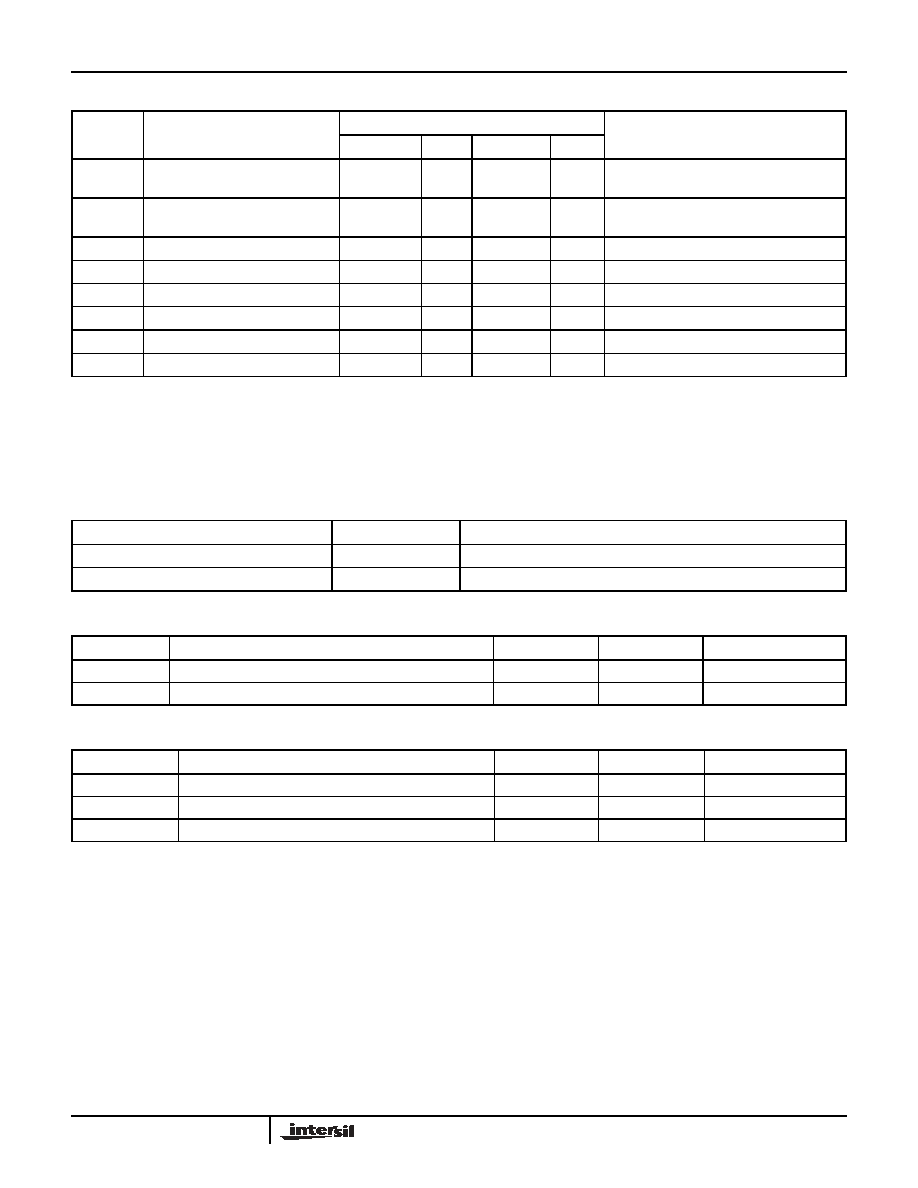
12
FN8168.1
May 6, 2005
D.C. OPERATING CHARACTERISTICS (Over the recommended operating conditions unless otherwise specified.)
Notes: (1) Absolute linearity is utilized to determine actual wiper voltage versus expected voltage as determined by wiper position when used as a
potentiometer.
(2) Relative linearity is utilized to determine the actual change in voltage between two successive tap positions when used as a potentiom-
eter. It is a measure of the error in step size.
(3) MI = RTOT/255 or (V
H
/R
H
--V
L
/R
L
)/255, single pot
(4) Max. = all four arrays cascaded together, Typical = individual array resolutions.
ENDURANCE AND DATA RETENTION
CAPACITANCE
POWER-UP TIMING
POWER UP AND DOWN REQUIREMENT
The are no restrictions on the sequencing of the bias supplies V
CC
, V+, and V- provided that all three supplies reach
their final values within 1msec of each other. At all times, the voltages on the potentiometer pins must be less than V+
and more than V-. The recall of the wiper position from nonvolatile memory is not in effect until all supplies reach their
final value. The V
CC
ramp rate spec is always in effect.
Notes: (5) This parameter is periodically sampled and not 100% tested.
(6) t
PUR
and t
PUW
are the delays required from the time the third (last) power supply (V
CC
, V+ or V-) is stable until the specific
instruction can be issued. These parameters are periodically sampled and not 100% tested.
(7) Sample tested only.
Symbol
Parameter
Limits
Test Conditions
Min.
Typ.
Max.
Unit
I
CC1
V
CC
supply current (Nonvol-
atile Write)
1
mA
f
SCL
= 400kHz, SDA = Open,
Other Inputs = V
SS
I
CC2
V
CC
supply current (move
wiper, write, read)
100
µA
f
SCL
= 400kHz, SDA = Open,
Other Inputs = V
SS
I
SB
V
CC
current (standby)
5
µA
SCL = SDA = V
CC
, Addr. = V
SS
I
LI
Input leakage current
10
µA
V
IN
= V
SS
to V
CC
I
LO
Output leakage current
10
µA
V
OUT
= V
SS
to V
CC
V
IH
Input HIGH voltage
V
CC
x 0.7
V
CC
+ 0.1
V
V
IL
Input LOW voltage
-0.5
V
CC
x 0.3
V
V
OL
Output LOW voltage
0.4
V
I
OL
= 3mA
Parameter
Min.
Unit
Minimum endurance
100,000
Data changes per bit per register
Data retention
100
years
Symbol
Test
Max.
Unit
Test Conditions
C
I/O
(5)
Input/output capacitance (SDA)
8
pF
V
I/O
= 0V
C
IN
(5)
Input capacitance (A0, A1, A2, A3, and SCL)
6
pF
V
IN
= 0V
Symbol
Parameter Min.
Max.
Unit
t
PUR
(6)
Power-up to initiation of read operation
1
ms
t
PUW
(6)
Power-up to initiation of write operation
5
ms
t
R
V
CC
(7)
V
CC
Power up ramp
0.2
50
V/msec
X9258

13
FN8168.1
May 6, 2005
A.C. TEST CONDITIONS
EQUIVALENT A.C. LOAD CIRCUIT
Test Circuit #3 SPICE Macro Model
AC TIMING (Over recommended operating condition)
HIGH-VOLTAGE WRITE CYCLE TIMING
Input pulse levels
V
CC
x 0.1 to V
CC
x 0.9
Input rise and fall times
10ns
Input and output timing level
V
CC
x 0.5
5V
1533
100pF
SDA Output
2.7V
100pF
10pF
R
H
R
TOTAL
C
H
25pF
C
W
C
L
10pF
R
W
R
L
Macro Model
Symbol
Parameter
Min.
Max.
Unit
f
SCL
Clock frequency
400
kHz
t
CYC
Clock cycle time
2500
ns
t
HIGH
Clock high time
600
ns
t
LOW
Clock low time
1300
ns
t
SU:STA
Start setup time
600
ns
t
HD:STA
Start hold time
600
ns
t
SU:STO
Stop setup time
600
ns
t
SU:DAT
SDA data input setup time
100
ns
t
HD:DAT
SDA data input hold time
30
ns
t
R
SCL and SDA rise time
300
ns
t
F
SCL and SDA fall time
300
ns
t
AA
SCL low to SDA data output valid time
900
ns
t
DH
SDA data output hold time
50
ns
T
I
Noise suppression time constant at SCL and SDA inputs
50
ns
t
BUF
Bus free rime (prior to any transmission)
1300
ns
t
SU:WPA
WP, A0, A1, A2 and A3 setup time
0
ns
t
HD:WPA
WP, A0, A1, A2 and A3 hold time
0
ns
Symbol
Parameter
Typ.
Max.
Unit
t
WR
High-voltage write cycle time (store instructions)
5
10
ms
X9258

14
FN8168.1
May 6, 2005
DCP TIMING
Note:
(8) A device must internally provide a hold time of at least 300ns for the SDA signal in order to bridge the undefined region of the falling
edge of SCL.
TIMING DIAGRAMS 2-WIRE INTERFACE
START and STOP Timing
Input Timing
Output Timing
Symbol
Parameter
Min.
Max.
Unit
t
WRPO
Wiper response time after the third (last) power supply is stable
10
µs
t
WRL
Wiper response time after instruction issued (all load instructions)
10
µs
t
WRID
Wiper response time from an active SCL/SCK edge (increment/decrement instruction)
10
µs
t
SU:STA
t
HD:STA
t
SU:STO
SCL
SDA
t
R
(START)
(STOP)
t
F
t
R
t
F
SCL
SDA
t
HIGH
t
LOW
t
CYC
t
HD:DAT
t
SU:DAT
t
BUF
SCL
SDA
t
DH
t
AA
X9258
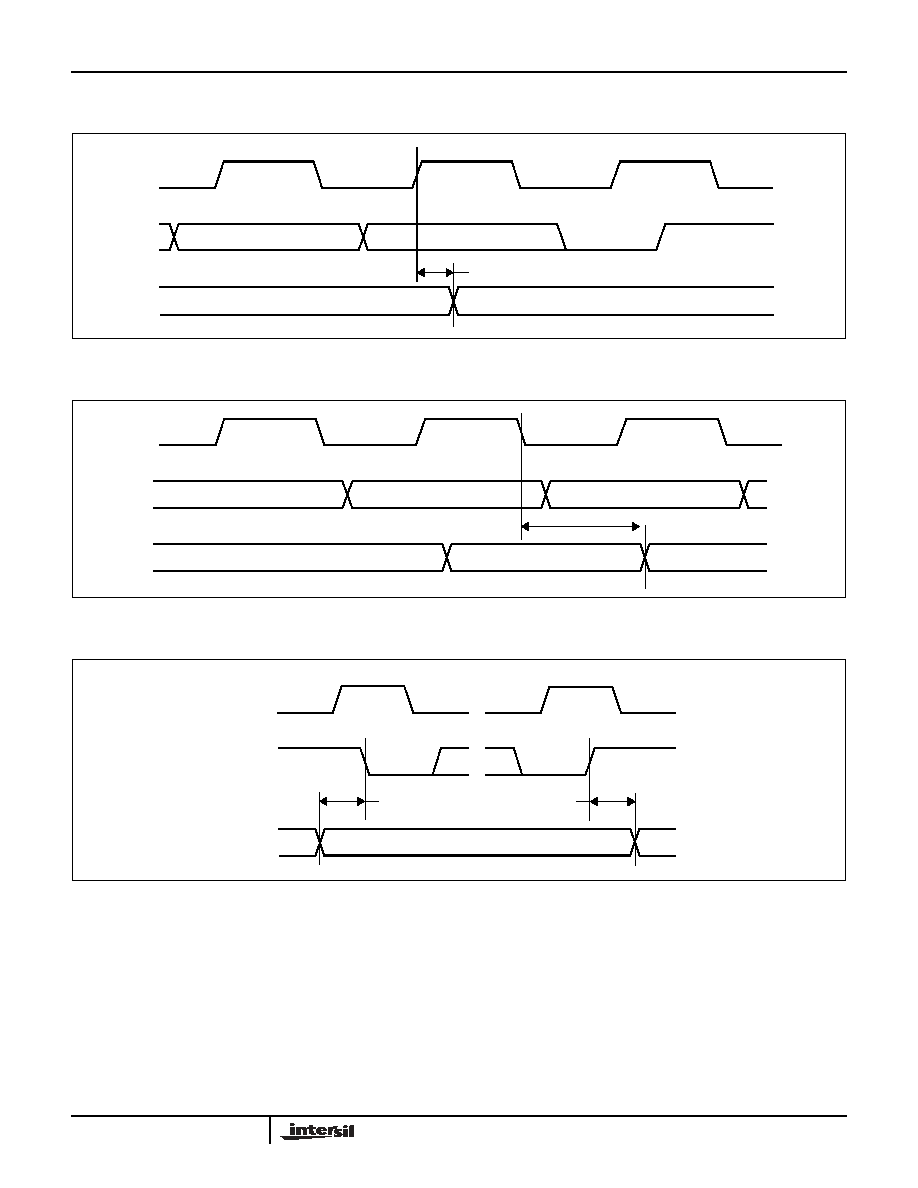
15
FN8168.1
May 6, 2005
DCP Timing (for All Load Instructions)
DCP Timing (for Increment/Decrement Instruction)
Write Protect and Device Address Pins Timing
SCL
SDA
VWx
(STOP)
LSB
t
WRL
SCL
SDA
VWx
t
WRID
Wiper Register Address
Inc/Dec
Inc/Dec
SDA
SCL
...
...
...
WP
A0, A1
A2, A3
t
SU:WPA
t
HD:WPA
(START)
(STOP)
(Any Instruction)
X9258

16
FN8168.1
May 6, 2005
APPLICATIONS INFORMATION
Basic Configurations of Electronic Potentiometers
Application Circuits
V
R
V
W
/R
W
+V
R
I
Three terminal Potentiometer;
Variable voltage divider
Two terminal Variable Resistor;
Variable current
Noninverting Amplifier
Voltage Regulator
Offset Voltage Adjustment
Comparator with Hysteresis
+
≠
V
S
V
O
R
2
R
1
V
O
= (1+R
2
/R
1
)V
S
R
1
R
2
I
adj
V
O
(REG) = 1.25V (1+R
2
/R
1
)+I
adj
R
2
V
O
(REG)
V
IN
317
+
≠
V
S
V
O
R
2
R
1
V
UL
= {R
1
/(R
1
+R
2
)} V
O
(max)
V
LL
= {R
1
/(R
1
+R
2
)} V
O
(min)
100k
10k
10k
10k
-12V
+12V
TL072
+
≠
V
S
V
O
R
2
R
1
}
}
X9258
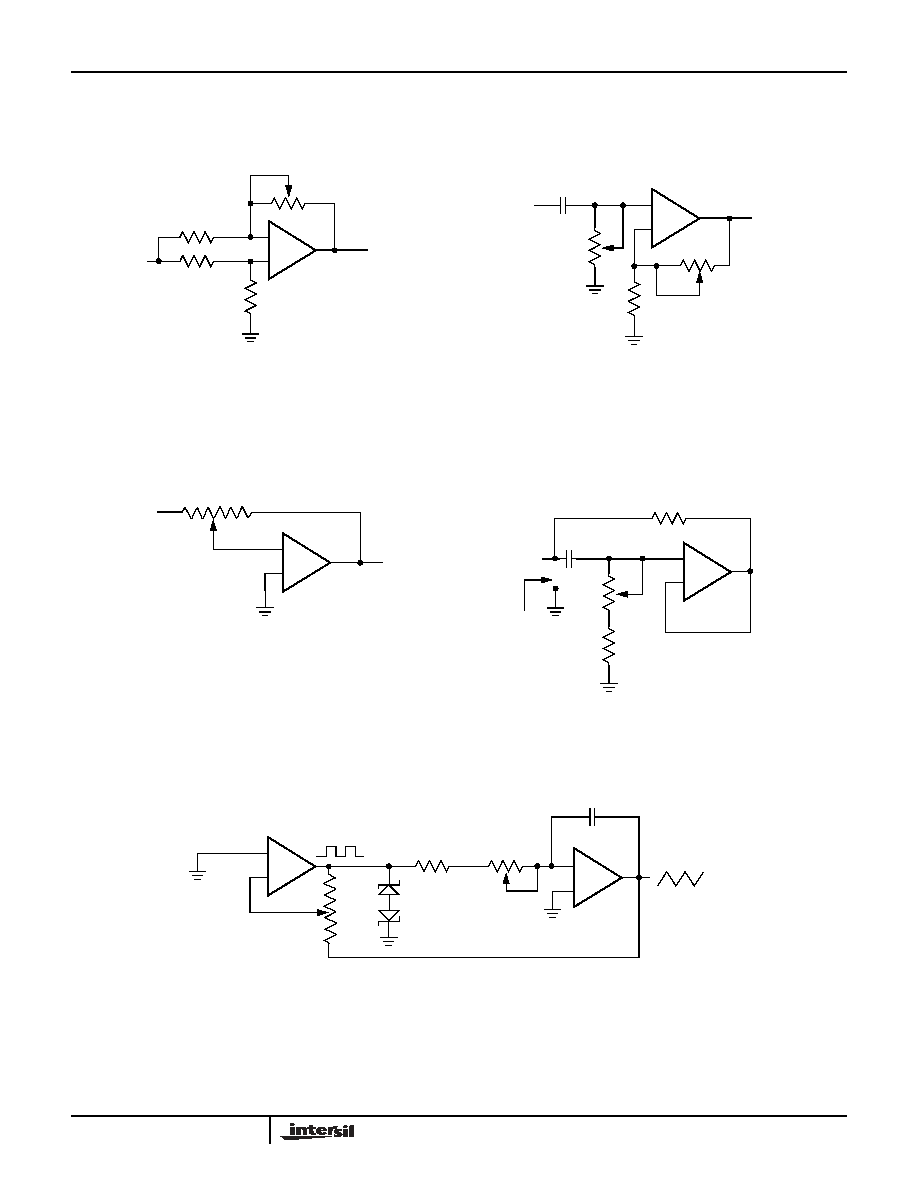
17
FN8168.1
May 6, 2005
X9258
Application Circuits (continued)
Inverting Amplifier
Equivalent L-R Circuit
+
≠
V
S
V
O
R
2
R
1
Z
IN
= R
2
+ s R
2
(R
1
+ R
3
) C
1
= R
2
+ s Leq
(R
1
+ R
3
) >> R
2
+
≠
V
S
Function Generator
}
}
V
O
= G V
S
G = - R
2
/R
1
R
2
C
1
R
1
R
3
Z
IN
+
≠
R
2
+
≠
R
1
}
}
R
A
R
B
frequency
R
1
, R
2
, C
amplitude
R
A
, R
B
C
Attenuator
Filter
+
≠
V
S
V
O
R
3
R
1
V
O
= G V
S
-1/2
G
+1/2
G
O
= 1 + R
2
/R
1
fc = 1/(2
RC)
R
2
R
4
All R
S
= 10k
+
≠
V
S
R
2
R
1
R
C
V
O
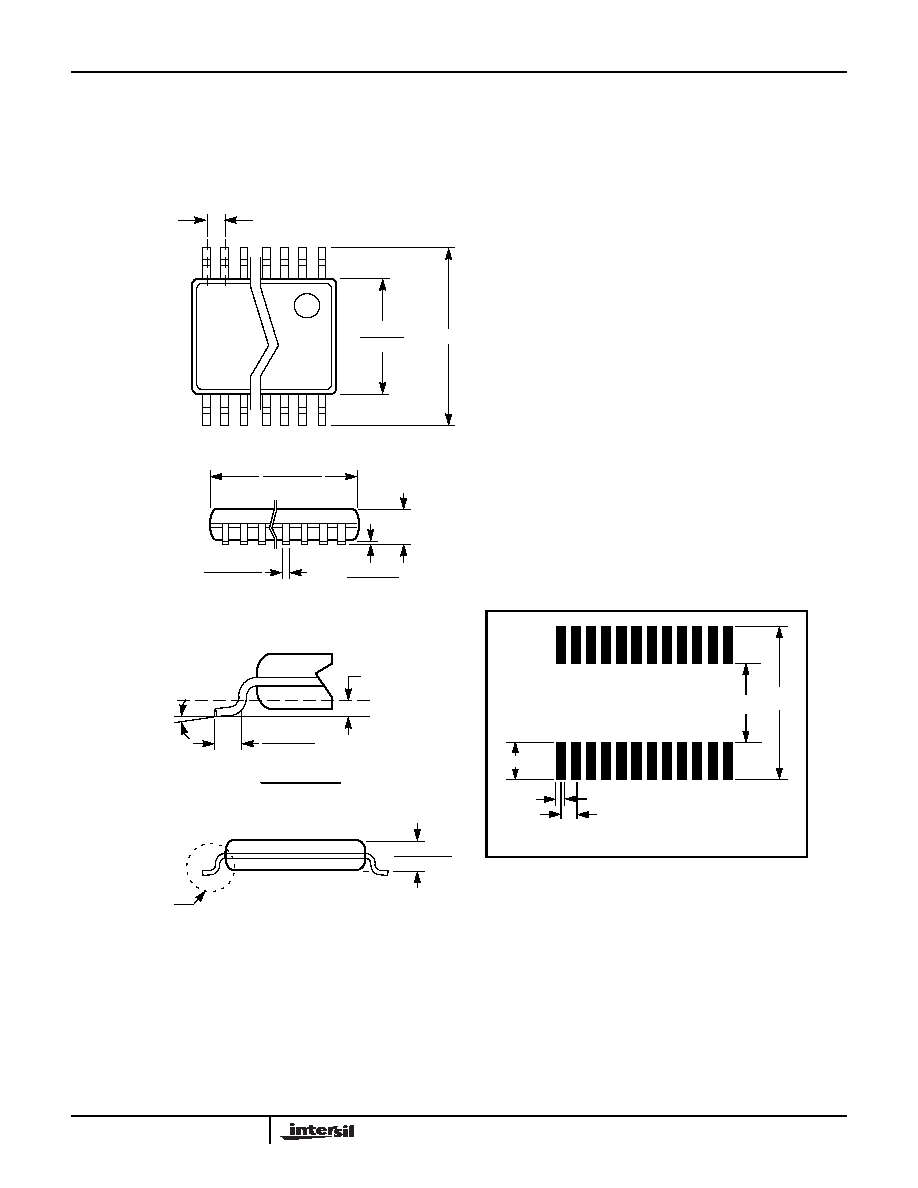
18
FN8168.1
May 6, 2005
PACKAGING INFORMATION
NOTE: ALL DIMENSIONS IN INCHES (IN PARENTHESES IN MILLIMETERS)
24-Lead Plastic, TSSOP, Package Code V24
.169 (4.3)
.177 (4.5)
.252 (6.4) BSC
.026 (.65) BSC
.303 (7.70)
.311 (7.90)
.002 (.06)
.005 (.15)
.047 (1.20)
.0075 (.19)
.0118 (.30)
See Detail "A"
.031 (.80)
.041 (1.05)
.010 (.25)
.020 (.50)
.030 (.75)
Gage Plane
Seating Plane
Detail A (20X)
(4.16) (7.72)
(1.78)
(0.42)
(0.65)
ALL MEASUREMENTS ARE TYPICAL
0∞ - 8∞
X9258

19
FN8168.1
May 6, 2005
PACKAGING INFORMATION
0.290 (7.37)
0.299 (7.60)
0.393 (10.00)
0.420 (10.65)
0.014 (0.35)
0.020 (0.50)
Pin 1
Pin 1 Index
0.050 (1.27)
0.598 (15.20)
0.610 (15.49)
0.003 (0.10)
0.012 (0.30)
0.092 (2.35)
0.105 (2.65)
(4X) 7∞
24-Lead Plastic Small Outline Gull Wing Package Type S
NOTE: ALL DIMENSIONS IN INCHES (IN PARENTHESES IN MILLIMETERS)
0.420"
0.050" Typical
0.050"
Typical
0.030" Typical
24 Places
FOOTPRINT
0.010 (0.25)
0.020 (0.50)
0.015 (0.40)
0.050 (1.27)
0.009 (0.22)
0.013 (0.33)
0∞ - 8∞
X 45∞
X9258
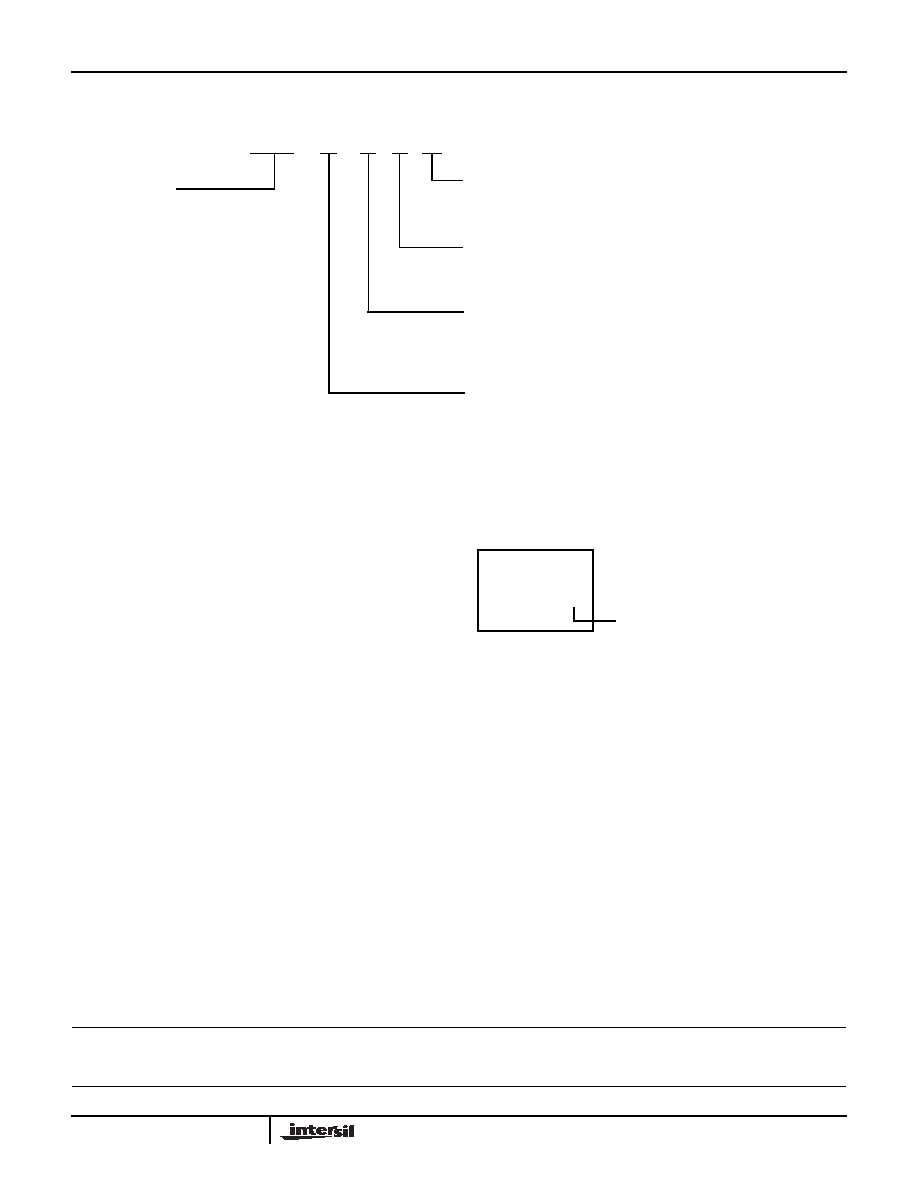
20
All Intersil U.S. products are manufactured, assembled and tested utilizing ISO9000 quality systems.
Intersil Corporation's quality certifications can be viewed at www.intersil.com/design/quality
Intersil products are sold by description only. Intersil Corporation reserves the right to make changes in circuit design, software and/or specifications at any time without
notice. Accordingly, the reader is cautioned to verify that data sheets are current before placing orders. Information furnished by Intersil is believed to be accurate and
reliable. However, no responsibility is assumed by Intersil or its subsidiaries for its use; nor for any infringements of patents or other rights of third parties which may result
from its use. No license is granted by implication or otherwise under any patent or patent rights of Intersil or its subsidiaries.
For information regarding Intersil Corporation and its products, see www.intersil.com
FN8168.1
May 6, 2005
Ordering Information
Device
V
CC
Limits
Blank = 5V
±
10%
-2.7 = 2.7 to 5.5V
Temperature Range
Blank = Commercial = 0
∞
C to +70
∞
C
I = Industrial = -40
∞
C to +85
∞
C
Package
S24 = 24-Lead SOIC
V24 = 24-Lead TSSOP
Potentiometer Organization
T =
100K
U=
50k
X9258
P
T
V
Y
S & V Package Marking
Line #1
(Blank)
Line #2
(Part Number)
Line #3
(Date Code) (*)
Line #4
(Blank)
= F
2.7V 0 to 70∞C
G 2.7V -40 to +85∞C
I
5V
-40 to +85∞C
X9258



















